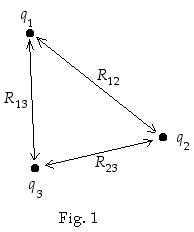Electrostatic Potential Energy
Physics
World
Back to Electrodynamics
The
force on a charged particle in a static electric field is given by the
definition of the electric field, E, as
![]()
Since it
can be shown that the electric field can be expressed as the negative gradient
of a scalar potential function F then
it follows from Eq. (1) that
![]()
The work
done on a charged particle as it moves over a curve at constant speed from point
A to B as
![]()
The
negative sign on the right hand side of the first equality expresses the fact
that force is applied in the direction opposite to the force due to the field.
The last equality on the right side of Eq.(3) follows from the work energy
theorem. V is the potential energy of a charged particle in an electric
field. Thus we find that V = qF
is the relationship between
electric potential and potential energy. The potential F for a point
charge is given by
![]()
Taking
the negative gradient of both sides of Eq. (4) we obtain

Consider
now a system of three charges. Start with a single charge q1
in isolation. Then bring in another charge q2
from infinity to a position near q1.
Then finally bring in a third charge q3
in from infinity to a position near both q2
and q1
as shown in Fig. 1 below

Then the
total work done in assembling this system of charges is then equal to the total
potential energy V of the system and found to be
![]()
Extending
this to a arbitrary number of charges yields

Extending
to a continuous system of charges gives
![]()